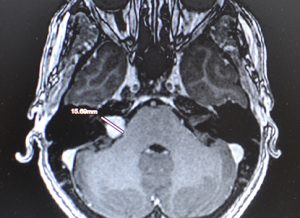Providing compassionate,
patient-centered care
Common Conditions & Treatments
Cochlear Implant (CI) technology has been around for roughly 50 years. Over the past 20 years, our knowledge regarding cochlear implants has grown tremendously and we as a society have witnessed tremendous advances in both the computing, software, and biomaterials used in these devices. At the time of this writing, it is estimated that over…
Read MoreMost cases of Otosclerosis are inherited in an autosomal dominant pattern with variable penetrance. In other words, you have a 50% chance of getting the gene from a parent with this gene; however, not everyone with the gene will develop symptoms. The onset of hearing loss is typically occurs when patients are in their 20’s…
Read MoreUnlike radiation utilized for treating cancer, stereotactic radiation for benign tumors is designed primarily to stop tumor growth by damaging the tumor cells and supporting blood vessels. Minor tumor swelling is expected immediately after treatment, which resolves in a few months. Patients with irradiated tumors will require lifelong follow up with MR to ensure tumors…
Read MoreThe normal anatomy of the human inner ear (organs of hearing and balance, which are located immediately adjacent to each other and are connected) is encased in very thick bone with only two ‘windows’ through which sound energy can enter and leave. This is vital to how we hear and is important in keeping sound/noise…
Read MoreIn the modern medical era, acoustic neuromas are typically found early in their course via MRI scan. The majority are small to intermediate in size (5-15 millimeters in diameter). Symptoms leading to diagnosis typically include asymmetric (one-side) hearing loss, dizziness, imbalance, and/or ringing in one ear. Rarely, patients may also describe facial twitching or weakness,…
Read MoreAll Treated Conditions
Lateral Skull Base Surgery and/or Stereotactic Radiosurgery
- Microsurgical Approaches
- Gamma Knife Radiosurgery
- Cyberknife Radiosurgery
- Acoustic Neuroma (Vestibular Schwannoma)
- Neurofibromatosis Type 2 (NF2)
- Meningioma
- Arachnoid Cysts
- Epidermoid Cysts
- Glomus Tumors
- Other Tumors of the Lateral Skull Base
- Cancers of the Temporal Bone and/or Surrounding Tissues
- Encephalocele/Meningo-encephalocele
- CSF Leak (From Ear)
Infectious and Acquired Disorders of the Ear
- Cholesteatoma (Congenital and Acquired)
- Otomastoiditis (Severe Ear Infections)
- Acute Otitis Media (Children and Adults)
- Eustachian Tube Dysfunction
- Chronic Otitis Media
- Otitis Media with Effusion
- Petrous Apicitis
Hearing Loss, Cochlear Implantation, Other Implantable Hearing Devices
- Cochlear Implant
- Hybrid (Electrical-Acoustic) Cochlear Implant
- Bone Anchored Hearing Aid (BAHA)
- Auditory Brainstem Implant
- Traditional Hearing Aids
- Sensorineural Hearing Loss
- Age related hearing loss (Presbycusis)
- Conductive and Mixed Hearing Losses
- Otosclerosis
- Laser Assisted Stapedectomy/Stapedotomy
- Tympanic Membrane Perforation
- Sudden Sensorineural Hearing Loss
- Tinnitis (Continuous or Pulsatile)
Ototoxicity
- Loud Noise Exposure/Acoustic Trauma
- Antibiotic Induced
- Chemotherapy Induced
Congenital (genetic) Ear Disorders
- Early or Delayed Onset Familial Hearing Loss
- Genetic Syndromes Affecting the Ear
- Aural Atresia
Facial Nerve Disorders
- Bell’s Palsy
- Temporal Bone Trauma/Fracture
- Facial Nerve Decompression
- Facial Nerve Tumors
- Ramsay Hunt Syndrome (Zoster Oticus)
- Sarcoidosis (Uveoparotid Fever)
- Nerve Grafting
Dizzy/Vertigo Conditions
- Benign Paroxysmal Positional Vertigo (BPPV)
- Meniere’s Disease
- Superior Canal Dehiscence Syndrome
- Vestibular Neuronitis
- Labyrinthitis
- Persistent Postural Perceptual Dizziness (PPPD)
- Vestibular Testing
Autoimmune and Systemic Conditions
- Autoimmune Ear Disease
- Sarcoidosis
- Wegener’s Granulomatosis
- Eosinophilic Otitis Media (Churg-Strauss Syndrome)





